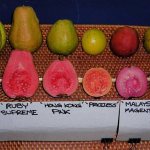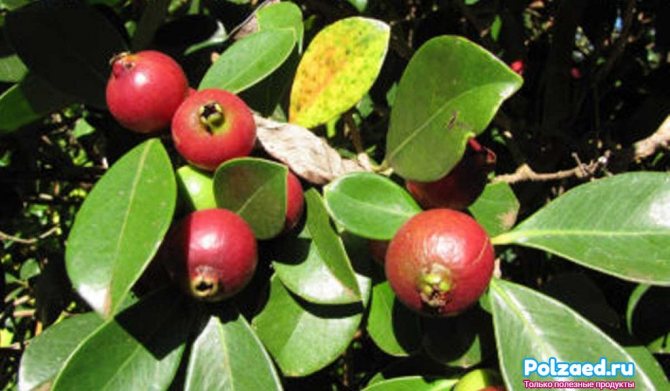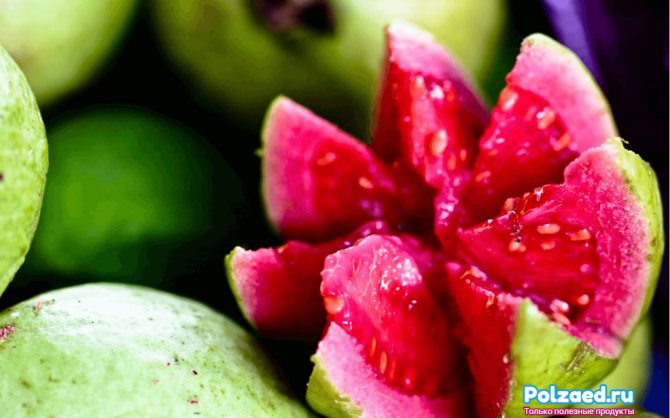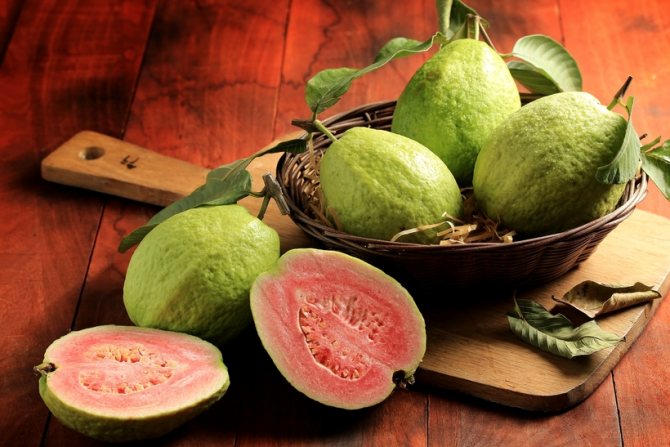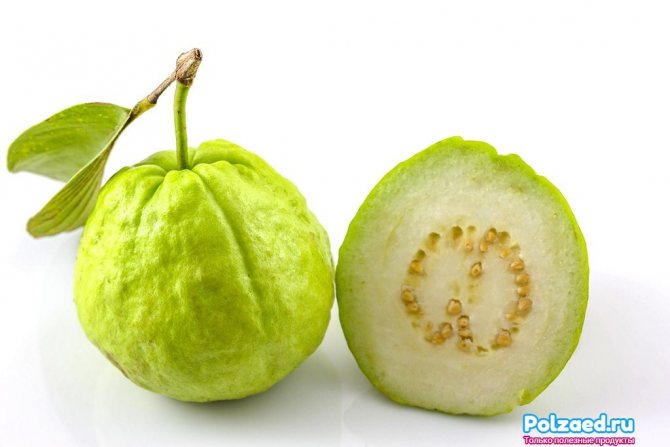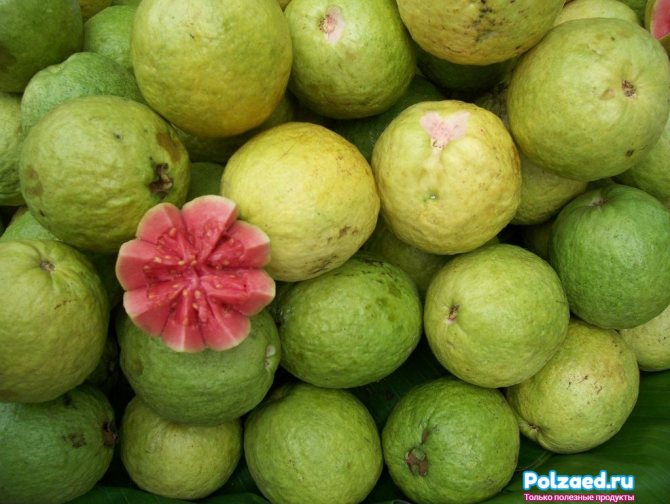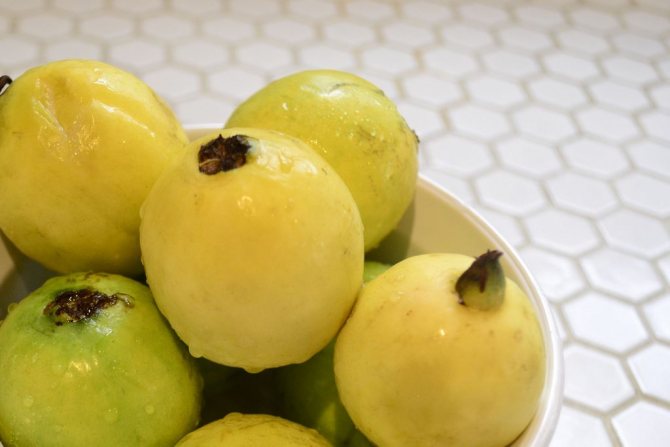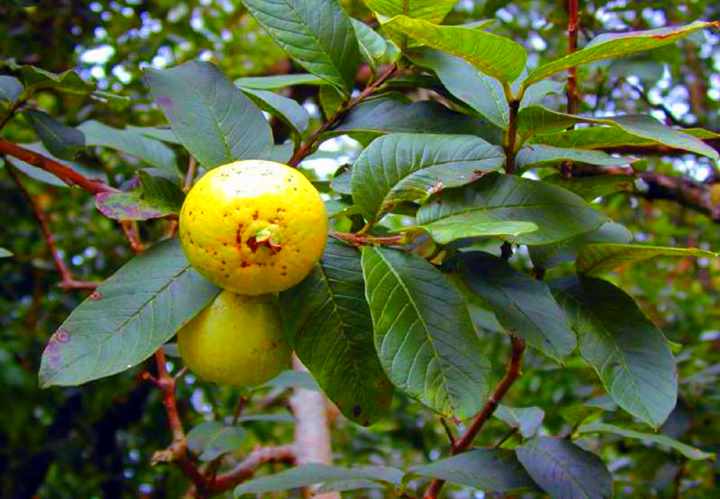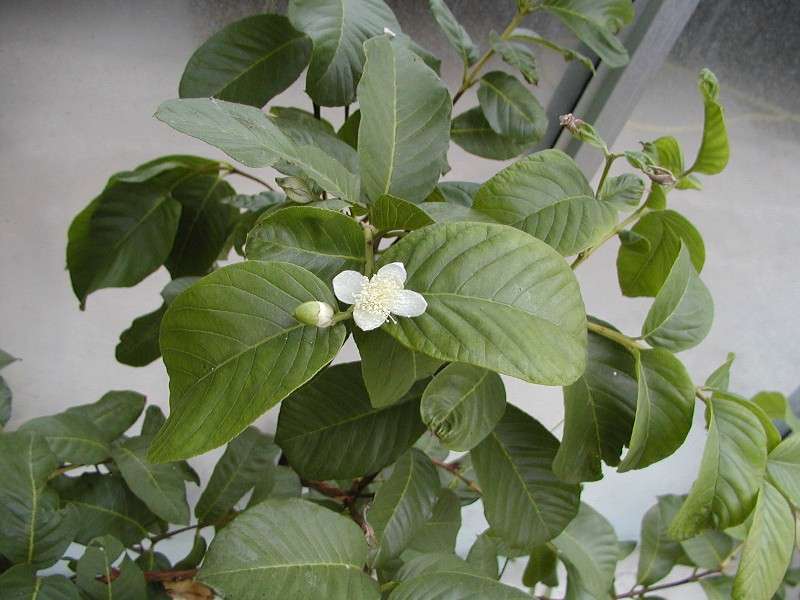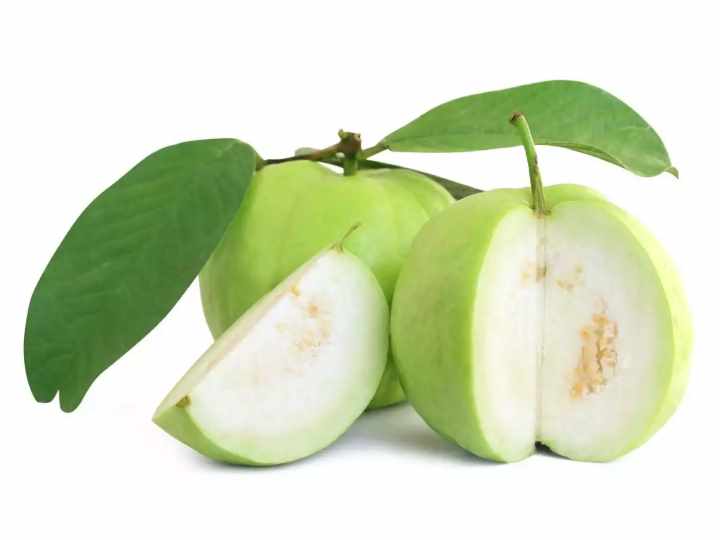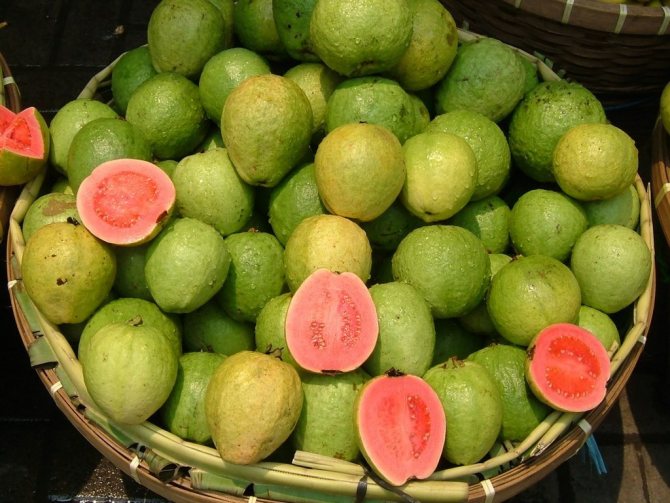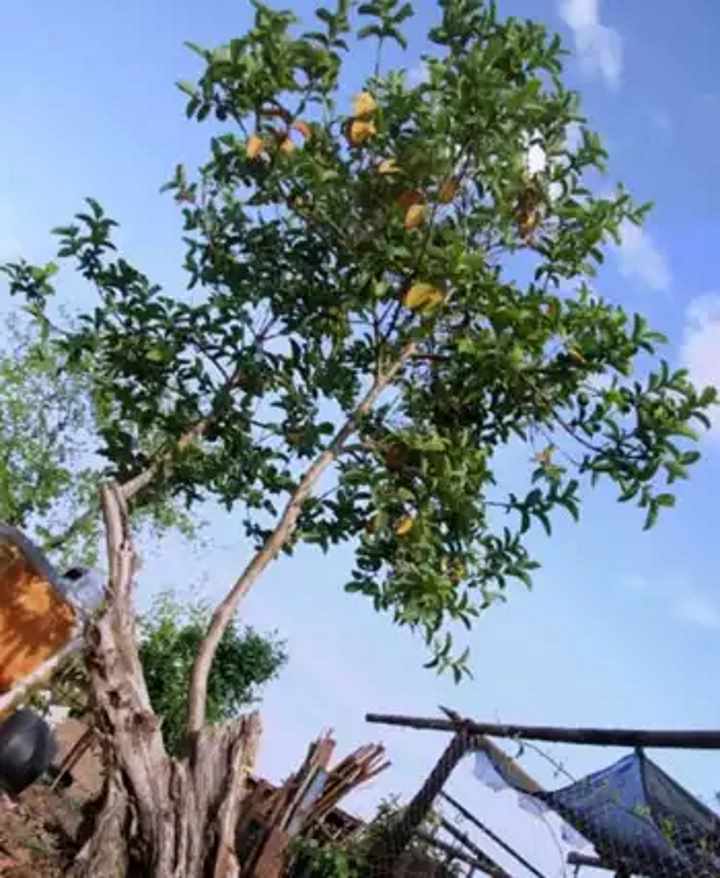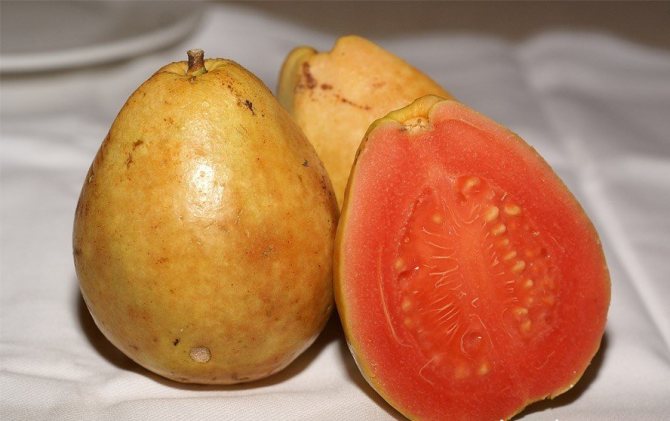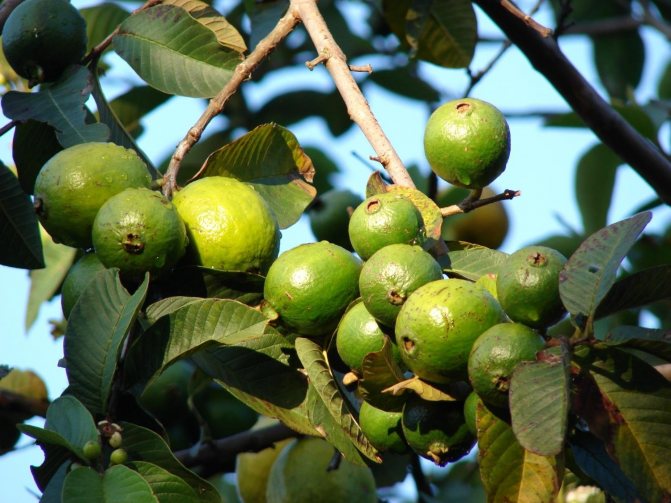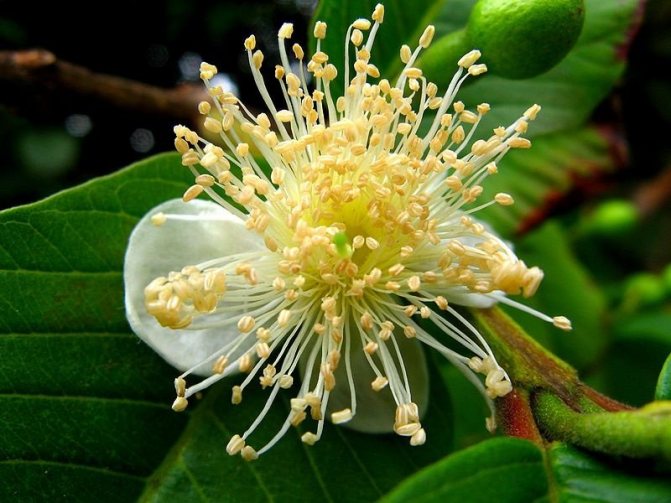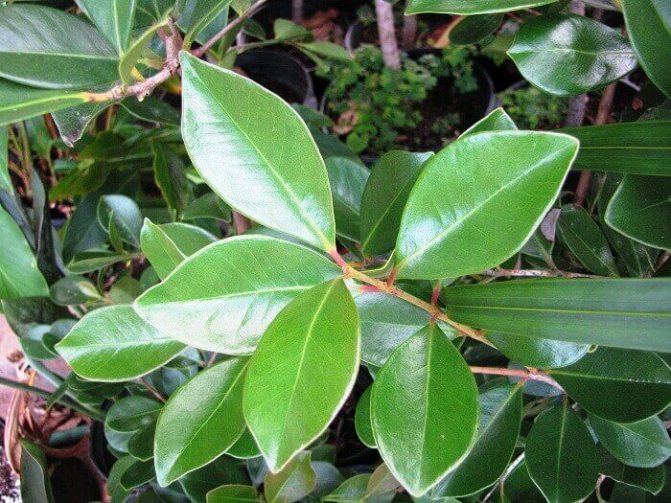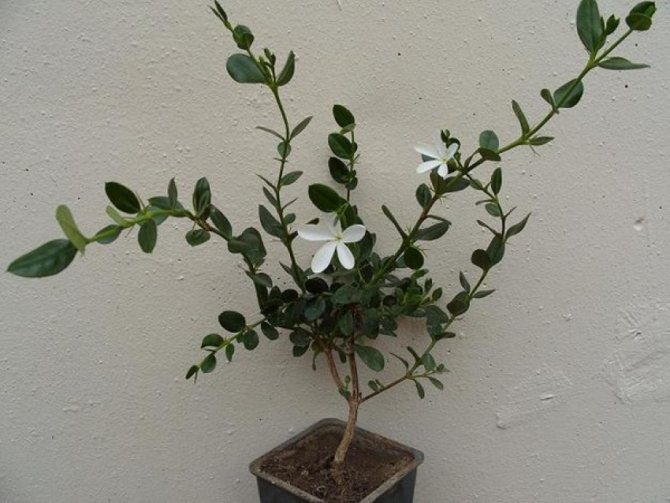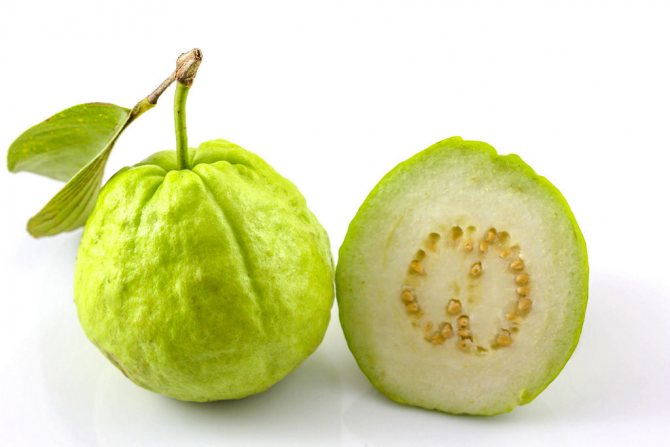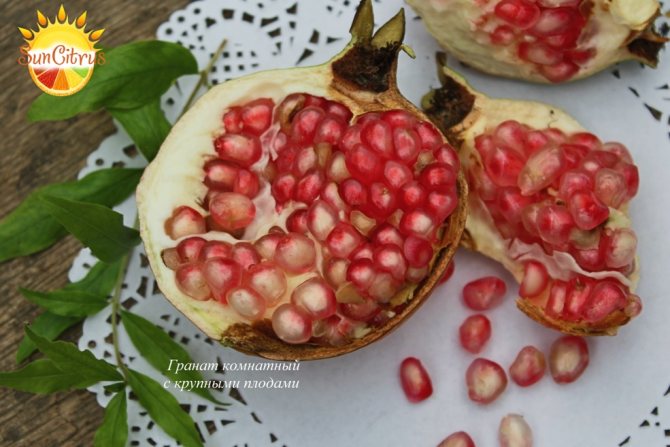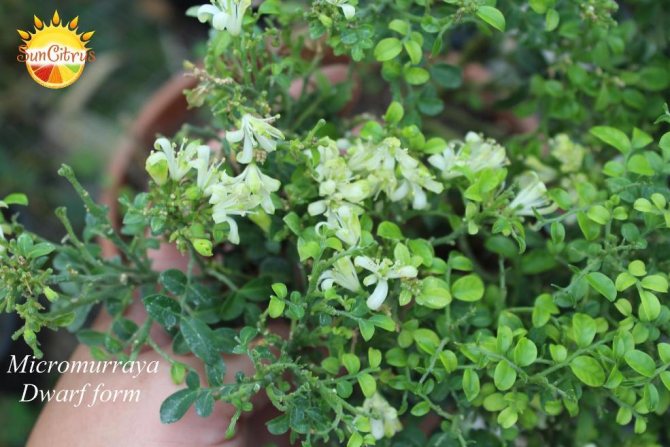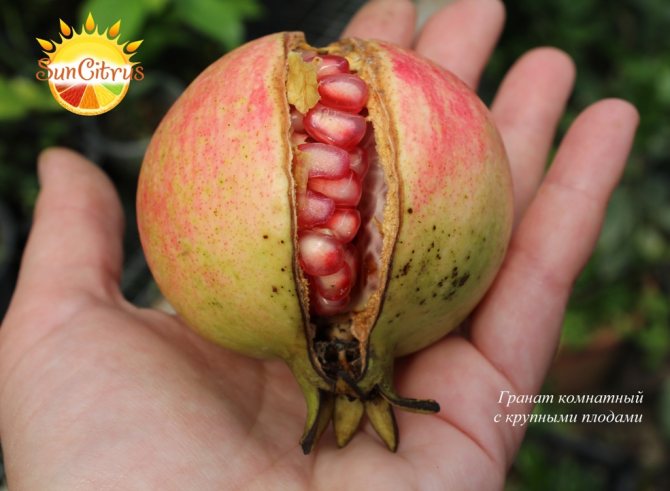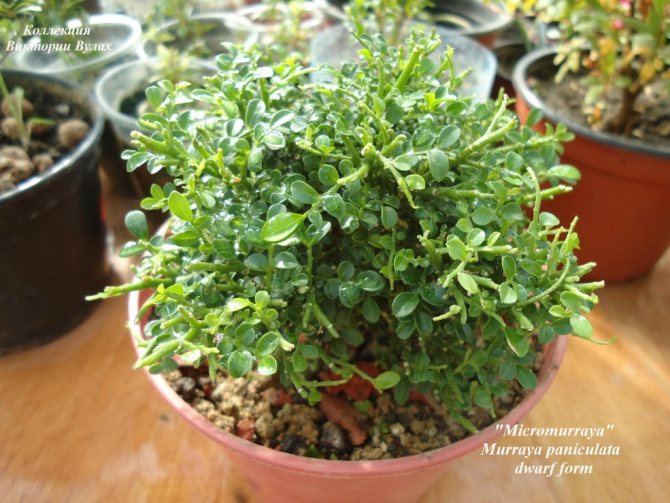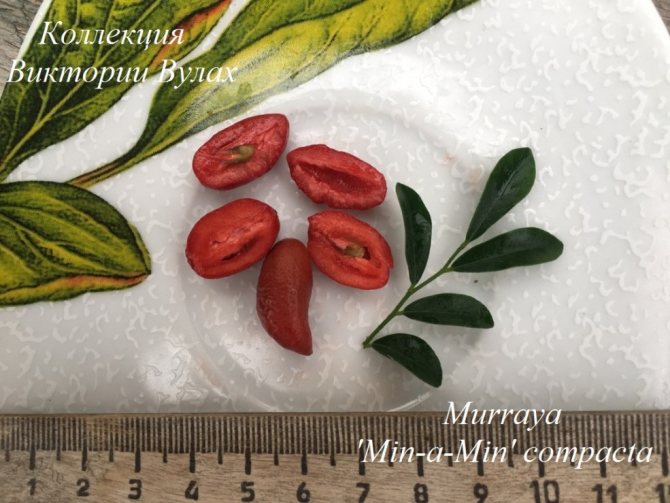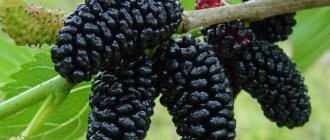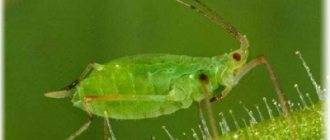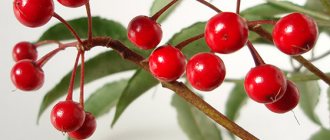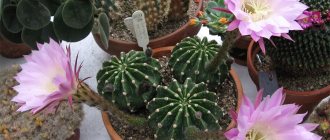Home »Exotic fruits» What is guava and what are the benefits of the fruit?
Sweet Raspberry 31.10.2018 Exotic fruits
Average rating + 2
no comments yet
- Region of origin and distribution of guava
- What does a tree look like?
- Taste and smell
- Why is guava often consumed immature?
- How to tell if guava is edible?
- Under what conditions is guava recommended?
- Contraindications
Often you want to pamper yourself with an unusual delicacy, but before you run to the store for a new chocolate bar, it is worth remembering that fruits are much more useful for health and for a figure. Do not forget about one of the amazingly healthy and nutritious fruits - guava, the so-called "tropical apple", rich in vitamins and minerals, which is endowed with truly healing qualities.
Description
The botanical name of the plant is Psidium guajava. This is an evergreen tree from the Myrtle family. It is also called guayava, guafa. The first evidence of her is recorded in Spanish documents dating back to the 16th century. It was discovered in Peru, and from there it spread to Asian countries, Africa, North America. In Thailand, guayava is a popular fruit called farang - a foreigner. It is also called a tropical apple for its external similarity.
Psidium does not stretch high up - only up to 4 meters. But some species can grow up to 20 m. The trunk is thin, with branches extended to the sides. Leaves are oval, 6-15 cm long. Flowering occurs 1-2 times a year. After 3-5 months, the fruits are formed. They are spheres or ellipsoids. The average fruit size is 8-10 cm.
There are about 100 varieties of psidium, so the fruits differ from each other in shape, taste and size. Some species are pear-shaped and squash-shaped. Their length is 15 cm and 7-8 cm is the diameter of the wide part. There are fruits with a diameter of only 3-4 cm. The skin color varies from pale green to bright green, some species are burgundy.
The color scheme of the inner part of the fruit is even more diverse. It can be cream, yellow, pink, red, cherry. The loose pulp is filled with hard small seeds, the number of which can reach 500. However, there are varieties without seeds at all.
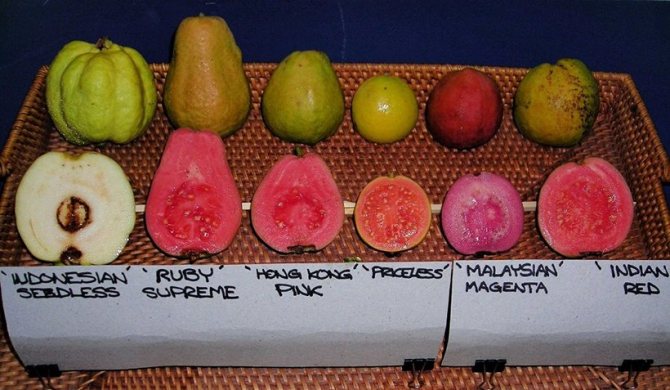
The peel of the guava is edible, just like the seeds of the plant. The crop is harvested 3-4 times a year, but the main one is one, when the tree produces up to 100 kg of fruit. Fruits are found in Asian markets all year round. In Thailand, you can buy a kilogram of guava for 30 baht (63 rubles).
Distribution and habitats
The tropics of South America and Mexico are considered the homeland of the guava, but the plant has spread beyond its natural range through cultivation. It is currently cultivated in southern Florida (USA), Bermuda, and throughout the West Indies from the Bahamas and Cuba to Trinidad and south to Brazil.
The first information about guava came from Hawaii in the early 1800s. There it grows everywhere: on pastures, roadsides, and also in bush forests at an altitude of 1200 meters above sea level.
Guava fruit trees do not grow in our latitudes, since they do not tolerate the cold weather characteristic of our country.These trees need to be protected from cold winds even in warm southern climates, where temperature drops sometimes also occur.
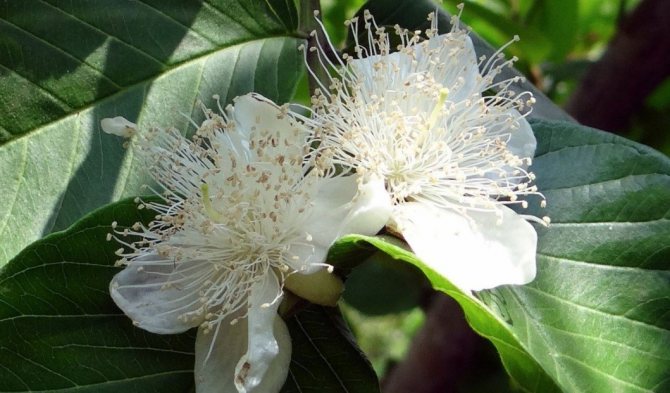

Learn how to grow pomegranate, ziziphus, kiwi, orange, lemon, gynostemma pentafusa, banksia, cucumber, pineapple, laurel, annona, rambutan, calamondin, anguria, banana, azimine, kiwano, luffa.
Varieties
Exporting countries grow many varieties of guava. Moreover, most countries cultivate certain varieties inherent in this region. Among the popular varieties that take up a large share of exports are:
- Common guava
- Strawberry
- Giant
- Guava cas
- Coronilla
The first two are the most common. Common is grown for consumption raw. Its most famous varieties: Supreme, Red Indian, Ruby. Strawberry is common in China, Colombia, Brazil. It is appreciated for its juiciness, sweet taste, and a small amount of seeds. Fruits are small in size - 2.5-4 cm. Its skin has a deep red color.
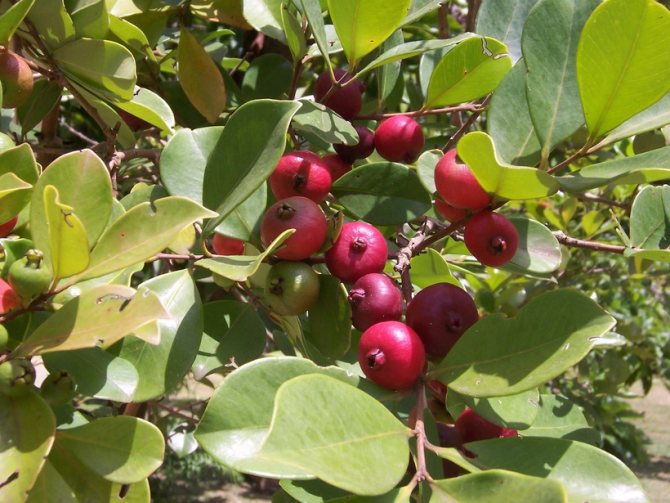

The exporter of the giant guava is Thailand. The fruits are quite large - up to 500 g. The pulp has a soft consistency, devoid of seeds. The Kas variety is appreciated for its taste. It is grown in Costa Rica, Singapore, Ecuador. Fruit is consumed fresh and used to make desserts and cocktails. Coronilla contains a large amount of ascorbic acid. Juices are made from it, canned, added to ice cream.
What is the best guava variety to grow at home
Those who want to get fresh fruits at home, it is better to take care of a guava variety that will quickly take root, can bear fruit in this climate, and is not very picky about soil and watering. Botanists consider Psidium Littorale or coastal psidium a suitable "candidate": it responds generously to warmth and care, does not get sick in indoor conditions, it is not afraid of worms, aphids, fungal diseases and scale insects.
In the photo there is a tree of strawberry guava (the fruit of the fruit is small and has a red "raspberry" color).
The advantages of the "coastal" variety of guava include beautiful flowers: relatively large, snow-white, eight-petaled, many stamens and extremely fragrant. Psidium has the usual dense green leaves. Its fruit ripens up to four centimeters, spherical in shape, the skin color is light yellow, fragrant, it will have the same qualities as growing in nature.
Beneficial features
Nutritionally, guava is a very valuable product, since the content of some trace elements in it is much higher than in more familiar fruits. Guava contains several times more vitamin C than citrus fruits (oranges, tangerines, lemons). It is very rich in dietary fiber, which allows it to be used to improve the functioning of the stomach and intestines. This fruit is twice as nutritious as apples. It is rich in sucrose, proteins and minerals.
Guava is far superior to bananas in terms of potassium and lycopene content. Eating the fruit replenishes the manganese reserves in the body, which is necessary for proper metabolism. It also contains minerals:
- potassium
- phosphorus
- magnesium
- selenium
- zinc
- iron
Thanks to such a set of nutrients, guava strengthens health and fills with energy. Regular consumption of the fruit acts on the body as follows:
- rejuvenates, promotes the renewal of the cellular system;
- increases the protective abilities of the body due to the presence of substances-immunomodulators;
- improves the process of food digestion. Fiber helps cleanse the intestines from harmful layers;
- restores the microflora of the stomach and intestines due to the bactericidal effect;
- strengthens the walls of blood vessels;
- increases brain activity;
- improves blood formation, has a positive effect on the lymphatic system;
- in case of diseases of the respiratory tract, it clears them of harmful accumulations;
- restores the activity of the thyroid gland;
- participates in the production of collagen, makes the skin elastic;
- restores hormonal levels.


The fruit is used for intestinal upset (diarrhea) to restore normal bowel function. You can also use it for dysentery without fear of dehydration. There are astringent elements in guava that do not exacerbate the laxative effect. Thanks to the disinfecting action, harmful bacteria are removed from the intestines. In case of food poisoning, the pulp of the fruit will help remove toxins from the outside.
A tropical apple is very useful for girls who are carrying a baby. Folic acid plays an important role in the formation of the baby's body. It affects the creation of DNA, ensures a normal metabolism. Folate is involved in all redox processes in the body. Thanks to this substance, healthy hair and nails grow, and the epidermis is regenerated. There are no restrictions on the use of guava for pregnant women as long as it is well tolerated.
Care and maintenance
Psidium guayava is capable of bearing fruit in small volumes of soil and is often grown as a container or potted fruit plant. But it develops especially well in ground greenhouses. Growth is quite fast, the annual growth is about 30 cm, and over the years the plant can develop into not a small tree.
The plant tolerates pruning and shaping well, but the field usually does not give this strong branching (in India and East Asia it is used to create bonsai).
The main difficulty in keeping a house in the temperate zone is the lack of light in the winter and the need to provide the plant with a cool, bright wintering, at + 12 ... + 15 0 C. Guayava prefers illuminated windows of east, south and west orientation, in summer it is advisable to take it out into the open air at the sun. When growing in a pot, care should be taken to ensure that the roots do not overheat in the sun. The rest of the psidium is undemanding, tolerates a short overdrying. It should be noted that brown spots often appear on the leaves, this slightly spoils the appearance of the plant. It is affected by mealybugs, scale insects.
On measures to combat these insects
- in the article
Houseplant pests and control measures.
Guayava vulgaris is easily propagated by fresh seeds. Having bought a ripe guava, you can eat its pulp by removing the seeds for sowing. By placing them in a container with soil (for example, soil for myrtle) and arranging a greenhouse, you will receive seedlings in 4-6 weeks. Seedlings 10 cm high can be planted in separate pots and grown in a warm, sunny place. Young plants love abundant watering and showers, but it is necessary to lightly dry the soil between waterings. The beginning of flowering and fruiting can occur in 2-8 years (on average, 2-3), and the plant has reached a meter height by this time.
In room culture, guavas are not very readily cuttings, only in greenhouses with lower heating and the use of root formers. However, the waiting period for rooting can last from 1 to 2 months, and its success rate is only 2%. It may be preferable to use the air lay method, although it is even more time-consuming.
In conclusion, we emphasize that for this tropical plant, warm, light and humid conditions are the ideal environment. Therefore, it will feel good in a subtropical winter garden, and in the summer it will respond gratefully to moving to a veranda, a greenhouse, a glazed gazebo or just to the sun in the open air.
Syn .: psidium, guayava, guayava.
Guava is a woody plant of the Myrtle family. It is an important crop in the area where it grows and is prized for its aromatic and nutritious fruits.The leaves, bark and fruits of the plant are used in folk medicine in some countries, and also serve as raw materials in the cosmetic industry.
experts
Flower formula
Guava flower formula: * CH5L5T∞P (3).
In medicine
Guava is not used in official medicine. However, guava is widely used in folk medicine in some countries, using almost all parts of the plant as an astringent, antipyretic, antispasmodic, bactericidal agent.
Contraindications and side effects
A strict contraindication is food allergy to guava, otherwise it is an almost safe fruit. The inside of the guava fruit contains many hard seeds that can irritate the throat.
It is better not to combine guava with sour and semi-sour fruits: mora (blackberry), lulo, passionfruit and tamarillo. Eating more than a kilogram of guava can lead to indigestion.
It is better not to eat unripe guava fruits, as they contain arabinose and hexahydroxydiphenic acid ester, which negatively affect kidney function. It is also recommended that you consult with a specialist before consuming guava fruit if you are pregnant, breastfeeding, or intending to feed the fruit to your baby.
In cooking
The maximum benefits of guava fruits are obtained when consumed fresh. The taste of guava pulp is sweet and sour, the fruits are very juicy and aromatic. Guava seeds are quite small and it is almost impossible to clean the fruit of them, so guava is eaten with them. Ripe guava fruits can be eaten even with the peel.
The calorie content of guava is low, about 68 kcal per 100 g of product, so you can not be afraid that its use will cause excess weight.
Also, juice is obtained from guava, which perfectly quenches thirst, jams, jam, syrups are prepared. The guava has a rather sugary consistency, so the fruit is combined not only with sweet, sweet and sour "brothers", but also with all dairy products. Most often, guava is added to salads, waffles, puddings, ice cream, milkshakes, marmalade.
When canned or frozen, guava also retains its beneficial properties. In a normal refrigerator compartment, undamaged and ripe fruits can be stored for about two weeks.
When buying a guava, pay attention to the peel so that it is not damaged. It is better to choose fruits that are slightly soft and the most yellow.
In cosmetology
Guava leaf, fruit and seed extracts are used as ingredients in various cosmetics, enhancing their tonic properties. Due to the beneficial substances contained in guava, creams based on it restore collagen in skin cells, restore elasticity, smooth mimic wrinkles, and nourish the skin well. Freshly squeezed guava juice can be used as a hair rinse, and guava pulp is used to make face masks.
Guava has both astringent and anti-inflammatory properties. Thanks to this, effective cosmetics against acne have been developed on the basis of guava extract and oil.
In other areas
In gardening
Guava is a fairly widespread unpretentious plant and is grown in almost all subtropics and tropics: Asia, Israel, India and Africa.
Guava is unpretentious and not particularly demanding of the surrounding conditions. The plant can grow in almost any climate, as long as there is no severe frost. Heavy clay, sand, gravel and even limestone are suitable for growing guava. Due to the shallow root system, the plant is demanding for watering. Guava trees are self-pollinated (however, there are species that need cross-pollination), the fruits ripen in 3-5 months. Fruiting of a plant occurs in several "waves": one main crop can bring up to 100 kg of fruits from a tree, and then 2-4 additional, much smaller crops.
In Russia, undersized and bushy guava varieties are popular as indoor exotic crops.The maintenance of the plant does not require special conditions, however, the guava needs good lighting, normal room temperature and regular watering (preferably with warm water). In the summer, the guava can be taken out into the fresh air, but the plant should be protected from direct sunlight. In early spring, the guava is transplanted as it grows and pruned.
In other areas
Guava wood is used for interior decoration. Combs, pens, engravings are also made from it. The leaves of the plant are used as raw materials for producing black dye.
Ripe guava has an incredibly strong and pleasant scent that can even drown out the smell of tobacco in a smoky room.
Classification
Guava (lat. Psidium) is a genus of plants of the Myrtaceae family (lat. Myrtaceae), includes about 100 species.
Botanical description
Guava is a small evergreen or semi-deciduous tree of the Myrtle family. Usually it grows up to 3-4 m in height, but there are specimens up to 20 m.When growing, it spreads branches widely.
Guava leaves reach 10-15 cm in length (in varieties cultivated in Israel, about 6-9 cm), opposite, whole-edged, oblong-ovoid or oval, slightly pubescent below, glabrous above, dark green in color.
The bark of the trunks is 2-4 cm thick, smooth, pale pink outside, with cracks.
Flowers are single with four to five petals, or gathered in groups, in the leaf axils; fragrant, greenish-white or pure white, up to 2.5 cm in diameter. Guava flower formula - * CH5L5T∞P (3). Guava blooms almost all year round. Some varieties require cross-pollination, and some are self-pollinating. The main pollinators are honey bees.
The guava fruit is usually round, sometimes oval or pear-shaped, and has a pleasant musky scent. The thin skin can be yellowish white, bright yellow, reddish, greenish white, or green. The shape, size and other characteristics of the fruit vary depending on the species and growing conditions. The mass of fruits of cultivated varieties is usually from 70 to 160 g, the length of the fruit is from 4 to 6.5 cm, the diameter is 4.8-7.2 cm.The flesh of the guava fruit is white, yellowish, pink or bright red, it contains several hundred small hard seeds, up to 3 mm long. However, there are guava species with seedless pulp.
Spread
The homeland of the guava is considered to be South and Central America, presumably the territory of Peru. After the Spanish found the plant in Peru and Colombia, it spread to almost the entire tropical region of South America. Some guava species are native to Africa, India, Southeast Asia and Oceania. The main exporting countries of guava are India, Brazil, Mexico, USA, Israel, Pakistan, Colombia and Egypt.
Procurement of raw materials
Guava has a fairly long flowering period, so the duration of the fruit season is almost year-round. Fruits are harvested only by hand.
Guava fruits are harvested unripe, then they are stored longer. Fresh guava is perishable, so the harvested fruit should be kept in the refrigerator. Just keep in mind that guava very easily absorbs unwanted odors. The fruit can be frozen, however, a significant part of vitamin C is lost, but the taste is completely preserved.
In addition to unripe fruits, the bark of this shrub is also valued. Fresh leaves are also used for medicinal purposes, but most often dry herbal preparations from leaves, flowers, bark and branches are prepared from guava.
Chemical composition
From a medical point of view, the shoots bark and immature guava fruits are of the greatest value. The bark of the plant contains ellagic acid, its diglycosides, leukodelphinidin, saponins. The chemical composition of the bark depends on the age of the plant.
Immature guava fruits contain a lot of insoluble calcium oxalate, soluble salts of potassium and sodium oxalate, protein, carotenoids, quercetin, giyarivin, halic acid, cyanidin, ellagic acid, free sugar (up to 7.2%), etc. Also, immature fruits have a very high acidity (pH 4.0), contain an ester of hexahydroxydiphenoic acid with arabinose, which disappears in ripe fruits.
Sesquiterpenes, tannins and leukocyanidin are found in all parts of the plant. In addition, guava roots contain b-sitosterol, quercetin. Essential oils containing cineole, benzaldehyde, caryophyllene and other compounds are released from the leaves.
Pharmacological properties
Despite the fact that guava has no use in official medicine, it still has some healing properties, for example, astringent, bactericidal and antispasmodic. But first of all, guava is a valuable food product. Eating guava fruit improves digestion, has a positive effect on heart function and normalizes blood pressure.
Due to the high content of vitamin C, this fruit is used to strengthen the lymphatic system and increase the tone of the body. For the same reason, nutritionists recommend including guava in the diet of nursing mothers and children, however, only after consulting a specialist.
The tannins, which are part of the guava chemical composition, are able to have a fixing effect, which allows you to take the fruit during an upset stomach. Guava fruit helps to remove phlegm from the bronchi, thinning it and making it easier to breathe. Fresh guava leaves also contain high levels of tannins and essential oils, giving them wound healing properties. This is what determines the appropriateness of the external use of a decoction of guava leaves for skin diseases, boils, inflammatory processes in the oral cavity, toothache, sore throat and cough.
Extract of leaves, guava fruit and essential oil of the plant have pronounced nourishing, moisturizing, astringent and soothing properties. The lycopene in guava essential oil has a powerful protective effect that prevents free radicals from damaging skin cells.
Guava oil, used in aromatherapy, has high antimicrobial properties.
Application in traditional medicine
Guava is widely used in traditional medicine in the countries where it grows. Healers use the leaves, bark and flowers of the plant for medicinal purposes. A decoction made from guava leaves is used as a cough suppressant, mouthwash and sore throat. Guava decoction is used for skin diseases or as an antipyretic agent.
In Brazil, guava fruits are eaten for diarrhea, in Panama - against asthma, bronchitis, pneumonia and throat inflammations, in the West Indies - against epileptic seizures and seizures, in the Philippines - against heart disease.
Tea made from guava leaves also helps with dysentery, stomach upset and dizziness, and helps to regulate menstrual cycles.
The crushed leaves are applied to fresh and abscess wounds. The leaves are also chewed to relieve toothaches. A decoction of the leaves is used for skin diseases and as an antipyretic agent.
Historical reference
The first mentions of the guava are found in the book "Chronicle of Peru" by Cieza de Leon in 1553. Archaeological excavations carried out in Peru have shown that local people cultivated guava several thousand years ago. In the distant past, the scent of the guava tree made the Spaniards think they were in an earthly paradise. Since then, historians, travelers and scientists have been trying to describe and repeat this wonderful smell.
Later, the plant was cultivated in all tropical and some subtropical regions of the world.
It is noteworthy that the indigenous peoples of North and Latin America - the growing area of the guava - used the oil and parts of this plant as an anesthetic and repellent.
Literature
1. Bernd Novak, Bettina Schultz Tropical fruits. Biology, application, cultivation and harvesting. - M .: BMM, 2008 .-- 240 p.
2. Larina T.V. Tropical and subtropical fruits. - M .: DeLi print, 2002 - 254 p.
3. Nikolaeva MA / Merchandising of fruits and vegetables: Textbook for universities. - M .: Economics, 1990 - 228 p.
4. Pugacheva E.A., Serebryakov S.R. Malaysia. Tropical fruits. - M., 2008 .-- 300 p.
It is also known under the following names: psidium guayava, psidium guayava, guayava and guayava. In Latin, the name of this plant will sound like this: Psidium guajava. The common guava is one of the plants of the family called myrtle, in Latin the name of this family will be: Myrtaceae.
Description of the common guava
In order for this plant to develop favorably, it will be necessary to provide it with either a solar light regime or a partial shade regime. As for the degree of air humidity, it can be kept at an average level. Throughout the summer period, the plant will need to provide abundant watering. The life form of this plant is an evergreen tree. The plant can often be found in indoor conditions, in addition to this, the common guava also grows in numerous greenhouses and in subtropical winter gardens. As for the maximum size in culture, this plant can reach about three meters, it should be noted that the common guava will grow quite quickly and in one year it can add about thirty centimeters in growth.
Description of the features of cultivation and care of common guava
For a favorable cultivation of this plant, one should not forget about regular transplanting. It is noteworthy that young specimens of common guava will need such a transplant every year, as for older plants, it will be quite enough to transplant once every few years. At the same time, for common guava, it is recommended to give preference to pots of standard proportions. It should be noted that this plant is distinguished by its particular unpretentiousness to soil soil, for this reason it is quite permissible to use a universal soil or soil that is intended for myrtle plants with drainage. The acidity of such soil soil of ordinary guava can be both alkaline, neutral, and slightly acidic. It should be noted that the common guava will tolerate pruning and shaping quite well. It is recommended to resort to such measures just before the beginning of the period of active growth of this plant, which is done so that pruning does not entail very strong branching. It is also important to remember the fact that pruning of this plant will not in any way harm further fruiting, which is due to the fact that the flowering of the common guava will occur only on young growths. As for the lighting of this plant, the optimal mode is direct sun, but a small partial shade will also be acceptable. The optimal temperature regime will be about twenty to twenty-five degrees Celsius. It is noteworthy that the common guava can tolerate both short-term waterlogging and short-term drying. It is important to remember that young specimens will need to constantly keep the soil moist. It is also necessary not to forget about top dressing: for this purpose, complex fertilizers should be used, which are intended for fruiting plants. Throughout the rest period, it is important to maintain a temperature regime between twelve and fifteen degrees Celsius. At the same time, the illumination should also remain quite intense, and watering can be provided in a moderate mode.The propagation of this plant can take place by means of fresh seeds, but one should not forget that the seeds will rather quickly lose all their germination. Such seedlings most often bloom in the second or third year. It is noteworthy that the cuttings rooted rather poorly, while bottom heating of the soil and treatment with stimulants will be required.
Where does guava grow
... Brazil.
What it looks like.
Guava, guayava or psidium are shrubs or small trees with spotted greenish bark and attractive serrated leaves 8 - 18 cm long. The leaf plates are dark green above and lighter below. Mature plants in their natural environment have small white flowers with a diameter of about 3 cm, which subsequently form round, oval or pear-shaped fruits. The berries have white, pink, yellow or even red flesh, taste sweet and sour and very aromatic. The leaves and flowers have a pleasant aroma.
Guava room - height
... As a houseplant, it mainly has the form of a shrub up to 1 m in height.
Guava diet
Guava is good for weight loss diet food. Its calorie content is low - only 68 kcal. This fruit has no contraindications (except for individual intolerance), so everyone can eat it. Due to its high fiber content, guava perfectly saturates, removes the feeling of hunger for a long time. She can replace breakfast, lunch, afternoon tea.
After eating the fruit, you do not want to eat for 3-4 hours, which is a big plus for those who do fasting days. The unusual taste of the fruit will help to interrupt the cravings for sweets and cakes. With the help of guava, you can carry out mini-diets for 2-3 days. This will allow you to lose one to two pounds to look slimmer before the holidays. The fruit eaten for breakfast will direct the digestive process in the right direction, fill you with vivacity. The high content of ascorbic acid will not allow you to be depressed on dieting days, it will improve your mood. A set of minerals and vitamins will fill the lack of nutrients, give strength to the body.
For weight loss, you can use not only fresh fruits, but also guava juice. From freshly squeezed nectar with the addition of milk, a very tasty and nutritious drink is obtained. During the diet, the fruit can be combined with low-fat yogurt, biokefir, oatmeal. Due to its unusual taste, the tropical apple is great for making low-calorie vegetable and green smoothies.
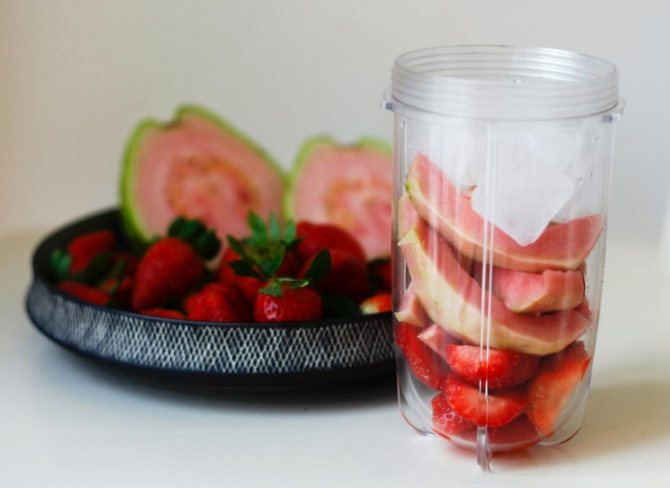

Planting and breeding guava at home
Psidium does not reproduce well from cuttings. They do not take root well and require a certain high temperature and humidity. Better to just pick the seeds from the guava you just eaten. Fresh and shallow planted, they sprout well. And in three years they will begin to bear the first fruits.
The guava pollinates itself. But, there is a small trick to increase the number of ovaries: with a brush, transfer pollen from a flower that has just blossomed to a flower that is already losing its snow-white petals.
Application
Guayava is widely used in the field of cosmetology. Seed oil and fruit extract are added to the composition of face masks, creams, peels. The substances in guava are used to fight wrinkles. Masks based on it smooth the skin, increase turgor. The fruit extract is able to influence the chemical composition of the epidermis. Brightening creams eliminate signs of hyperpigmentation, even out the tone of the face.
The plant's antibacterial properties help relieve the symptoms of inflammation in the pores. Guava oil heals acne, cleanses the skin. With its help, allergic rashes, acne, dermatological diseases are eliminated. The juice from the leaves of the plant also has healing qualities. It is used to treat wounds and skin lesions. Dry leaves are brewed like tea and drunk as an anti-inflammatory agent.In production, a dye is made from the leaves for finishing fabrics. Psidium wood is used to make interior details.
Home guava care


Potting soil preparation:
in order to form a runoff to remove excess moisture during irrigation, expanded clay is poured onto the bottom, then cow manure (a little) is laid, and a mixture of garden soil, sand, peat (2: 1: 1) or from earth, sand, humus (1: 1 :one).
Temperature range:
in order for guava seeds to sprout, heat is required from 22 to 28 degrees. In general, guava is a thermophilic plant and also loves light. Therefore, as soon as the still warm spring rays appear, the guava can be gradually transferred to the balcony. To provide enough moisture, guava can not only be watered into the soil, but also "rinsed in the shower" in the heat along with leaves and branches.
In winter, the temperature should be kept in the room from +16 to +20 ° C.
Young plants are sensitive to cold. In general, the minimum temperature that allows guava to develop is only +15 degrees. Frost damage (-2 ° C) damages foliage, at -3 ° C psidium irrevocably leaves its owners. Watering and feeding:
when shoots have appeared, the earthen coma should not be allowed to dry out. Because of this, young shoots dry out and leaves curl. The root system of the guava is superficial. Psidium is watered abundantly in the summer and as needed in the winter months. Guava is fed at home from autumn to the first sunny days with infused mullein.
Transplant:
when the psidium sprout has grown to 5 cm, it can be transplanted. Tall trees up to 75 cm in height are also suitable for transplanting. It is recommended to transplant the plant several times: first in a small container, then in larger ones, etc. This can be done in spring (March-April), but not during flowering and fruit emergence.
- When forming the crown of a guava tree, it must be borne in mind that the fruits appear on young shoots. If possible, it is better to refuse to cut the crown altogether, the path is formed independently. Or cut off only long branches.
- Remove root shoots so as not to end up with dense bushy thickets.
- The position of the guava cannot be drastically changed. She can drop foliage (partially).
- To get a bush, and not a stem tree, you need to pinch the growing point. It happens that you have to do this several times.
Caring guava owners, who planted a seed, looked after the bush, followed all the recommendations, will be happy with the result. First, a little (3-4) fresh healthy fruit, and then a few kilograms will be presented by the evergreen handsome psidium. From them you can make wonderful puddings, jams, fruit salads, etc., eat and maintain your health.
How to choose and eat
Due to the wide variety of varieties, when choosing a fruit, you should not focus on its color. Ripe guava can have a pale skin tone, depending on its type. In addition, the bumpy surface is a feature of the structure of these fruits. This creates an unpresentable appearance, it often seems that they are hard and tasteless.
When choosing a good fruit, you need to look first of all at the absence of damage. Signs of spoiled guava are dents, brown specks. The shriveled peel indicates that the fruit has been in the warehouse for a long time and has lost its freshness. The surface should be shiny, glossy. To the touch, a ripe guava is similar to a ripe pear - it is firm, elastic, the rind is slightly squeezed. When ripe fruits are cut, a bright fruity aroma is felt. The inside is loose, resembling watermelon pulp in structure. If the fruits are not ripe, they will taste sour. The fruit is stored in the refrigerator for 2-3 weeks. A slightly unripe fruit can reach at home, it must be placed on the windowsill or left on the table.


Unlike many other tropical fruits, guava can be eaten with its peel. It is edible and very healthy, but not everyone will like the taste, as it has a bitter taste.Also, the fruit is cut into slices and eaten with skewers. The seeds can also be consumed, but some throw them away - it's a matter of taste.
Impressions about the taste of guava are different. This aspect is largely influenced by the type of tree. It contains the flavor of strawberry, pineapple, spruce needles, raspberries. The pulp can be eaten with salt and pepper, or even spread on bread. It goes well with fruits, vegetables, fish and meat. Guava is used to make:
- preserves, jams
- puree
- marshmallow
- salads
- pastries
- desserts
- cocktails
Tropical peach pulp and juice are added to ice cream. This fruit is also pickled and then used as an addition to main courses. It is also dried and dried, in this form it is sold as a dessert.
Popular types of guava
Regular guava grows well in a pot. If the grower provides the plant with a warm, humid climate and good sunlight, the guava will bear fruit regularly.
There are several types of guava that are suitable for container growing:
- Tropical guava (Psidium guajava) - known for large and juicy fruits. Fragrant white flowers with long stamens appear on the tree throughout the year, gradually giving way to light green fruits with dark pink flesh inside. Ripe fruits are very fragrant. This variety is the most tender of all, it is more thermophilic than other varieties, and can grow up to 3-4 meters in height without pruning.
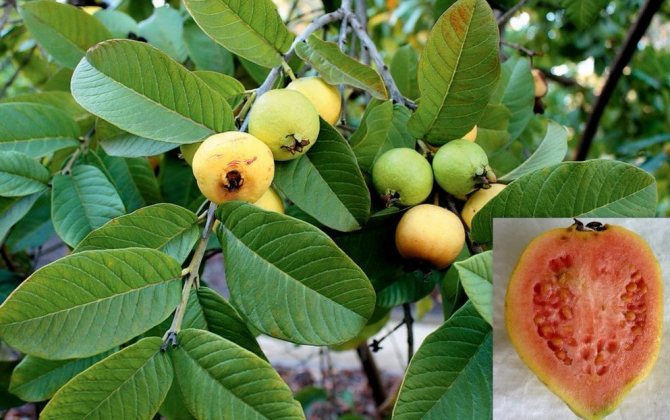

- Strawberry guavas (Psidium cattleianum) - a weed plant in many tropical regions, the Brazilian strawberry guava is perfect for container cultivation in countries with cold climates, provided that the plant is kept at temperatures not lower than + 10 ° C. The flowers of the tropical sissy are small, white and fragrant. The tree begins to bear fruit in August, with a suitable temperature regime, fruiting continues until winter. The fruits of this variety are round fruits with red skin and white flesh.
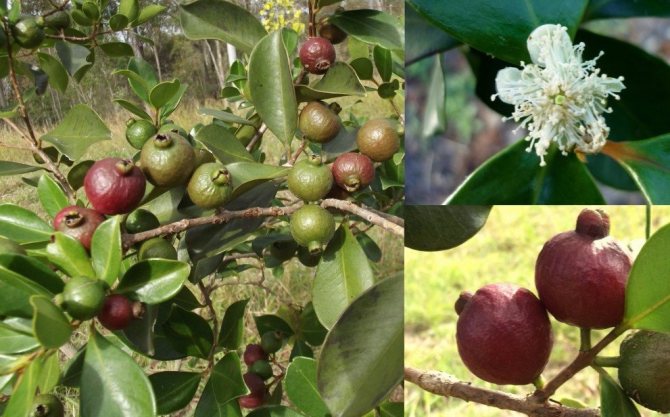

- Lemon guava (Psidium lucidum) - also suitable for container growing. This plant is small in the wild, and grows very compact in a pot, its growth (without pruning and pinching) stops at a height of 1.50 m. The lucidum variety has small white flowers and fragrant fruits with yellow skin and a tart taste.


- Pineapple guava (Feijoa Sellowiana) - is the most frost-resistant variety and tolerates low temperatures down to -9 ° C. The natural height of these trees reaches 3-4 meters. This variety is also grown both in soil and in containers.
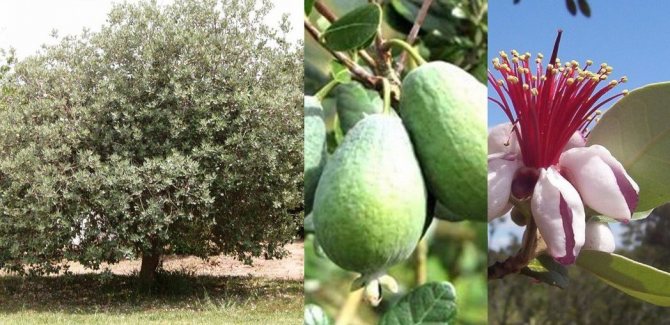

Pineapple guava, aka feijoa
Did you know? Potted orchids hide a true vampire character behind their graceful appearance. They have no place in the bedroom, it is at night that they most actively feed on energy. But where passions boil, emotions splash out, they will bloom best. Orchids are good companions of active, strong people, with an excess of internal energy and explosive temperament.
Harm from the use of an exotic fruit
Among most exotic fruits, guava is the least harmful and insidious among the rest of the tropical representatives. It should be carefully used only by those who:
- Prone to allergic reactions. Therefore, if a person has such a deviation, then it is necessary to take it in small pieces.
- When this fruit is used for the first time, it is necessary to very carefully introduce it into your diet. Starting with small doses, you can gradually increase its amount later.
- If too much of the pulp is eaten at one time, diarrhea may result.
- Unripe fruits are undesirable for those people who suffer from various functional abnormalities in the work of the kidneys and adrenal glands.
- If the fruit bites along with the seeds, you need to be careful so that the hard seeds do not damage the teeth.
What does guava taste like?
Fruits that have a slightly soft texture and are the same to the touch have the best taste.To say unequivocally what the taste of this exotic is like is very difficult. It is both sweet and slightly sour. Most often people associate it with a combination of pineapple and strawberry. Some, instead of strawberries, feel notes of raspberries or strawberries. Thanks to the mild acidity, others have an association with lemon.
If we talk about the taste of the skin, then here you can feel the smack of pine needles.
How to use
Fresh guava fruits will be an ideal option - they retain a maximum of useful properties, vitamins are not destroyed. But exotics processed in different ways are also quite tasty. If desired, salads, desserts, ice cream or whipped cream additives can be prepared from the fresh fruit pulp. If the fruit has time to overripe, then it is better to cut it in half and remove the pulp with a teaspoon or tablespoon.
It is worth knowing that the unripe skin of the fruit can have a healing effect. It is for this reason that in the homeland of the tree, guava is eaten with the peel. But it is not recommended to do this when buying fruits in a supermarket. After all, they are treated with different chemical compositions to increase the shelf life.
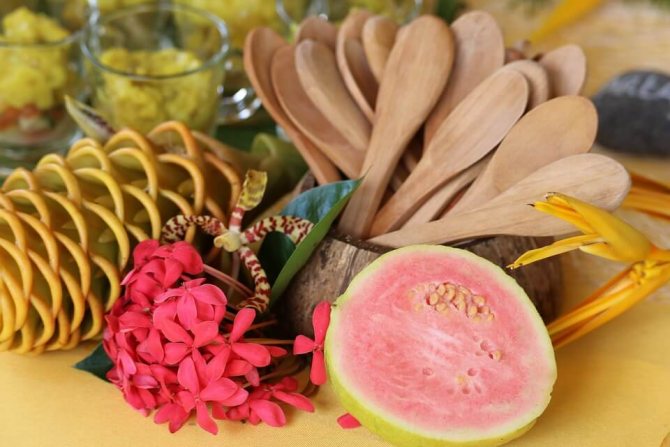

The seeds are also beneficial for human health. They contain a lot of different microelements, especially iodine. Essential oils also have many beneficial effects. Therefore, when cleaning the pulp, do not get rid of the seeds. A more exotic way to use guava is to add pulp to meat dishes or savory salads.
What can be made with guava
Guava is most often eaten raw, slicing the flesh into slices. But, at the same time, you can cook the following dishes from this fruit:
- Various types of compotes.
- Cocktail with added milk.
- Squeeze fresh juices.
- Prepare fruit salads.
- Add both whole fruit pieces and freshly squeezed juice from it to various alcoholic cocktails, making amazing exotic mixes.
- By adding other ingredients, especially superfoods, you can get various tonics and energizers.
- In combination with yoghurt, you can get different flavor combinations.
- Fruit cocktails are also prepared from guava with the addition of citrus fruits, various berries, bananas, pineapples.
- Can be used as pie filling. But it is worth considering that if you want to cut whole pieces, then it is better to choose dense fruits. If the filling is in the form of mashed potatoes, it is better to prefer soft ones.
- Guava-based creams have excellent taste. They are used in a wide variety of cakes and rolls, especially those with an exotic look.
- Ice cream is made on the basis of the fruits.
- In the countries of Asia and Africa, wine is made from this exotic fruit.
- In India, pieces of fruit are used to make chutney and eaten along with meat and fish.
How to store and choose an exotic fruit
You need to know that these fruits are not capricious in terms of storage. Therefore, they do not need to create special conditions:
- At room temperature, it will be unchanged for several days;
- If it is necessary to increase the period, then they are taken out to cool or put in the refrigerator.
But before choosing, you need to know what distinguishes a ripe and juicy guava:
- It doesn't have to be green and hard.
- The shade of the skin is yellowish or a pinkish undertone predominates even on green.
- In terms of its elasticity, the fetus has average indicators.
- Too soft will be overripe, due to which some of the taste is lost. In addition, the peel in this case is covered with brown small specks.
- You also need to smell the fruit. It should not give off unpleasant odors that are not typical of fruits.
- If there is a need to keep the exotic for at least 2-3 days, it is advisable to choose slightly dense ones. In such a slightly immature state, they can be easily brought to the desired condition by placing them in a plastic bag along with apples. Within 12-15 hours, the guava will become soft and ripe.
Interesting facts about guava
Here are the most interesting things about this plant:
- Guava is called a tropical apple.
- Unripe fruits are used as intensively as ripe ones. Their only scope is medicine.
- The essential oil is used for flavorings.
- A planted adult tree can give its first harvest no earlier than 2 years after planting in the ground. And sometimes it takes a tree as long as 8 years to start bearing fruit.
- The number of seeds in one fruit can reach up to 600 pieces.
A large number of biochemical substances have the most beneficial effect on the human body, maintaining its health at a high level. Therefore, if possible, you should not refuse to use this fruit, especially since it tastes so good.
Success secrets
Guava is quite demanding for air humidity. For spraying, it is recommended to use a fine atomizer. Water is taken warm, previously settled. Wet expanded clay or peat will also save the situation. It is placed on a pallet and a little water is poured into the bottom.
Monthly feeding will have a beneficial effect on the health of the plant. From early spring to late autumn, organic fertilizer is applied in a diluted form, it can be alternated with mineral fertilizer. It is enough to maintain Psidium three times a month. In winter, he does not need feeding.
Young specimens are transplanted every year. When Guava grows up, the substrate is replaced as needed. The plant is not demanding on the soil. Guava reproduces easily by seed. They are sown in containers and kept warm, in a well-lit place. In this case, the thermometer in the room should not fall below + 22-24 ° С. Cuttings root at temperatures several degrees higher. Seedlings are placed in separate pots when they reach a height of 10-15 cm.
If the plant is propagated by cuttings, half-green or mature material is picked up. Psidium feels as comfortable as possible in a greenhouse, where it develops rather quickly and bears fruit almost every year.
Where does guava grow
Today, this plant is common in almost all equatorial countries. On the American continent, it is planted in all tropical territories, Bermuda and the Bahamas. The Spanish and Portuguese colonialists brought this fruit to India and Guam at the dawn of American colonization. Guava grows throughout the tropical region of southeast Asia, Oceania, in climatic regions of Africa - Algeria, Palestine. Guava grows on the Mediterranean coast, in all the islands of the Pacific Ocean, where it can be seen in gardens.
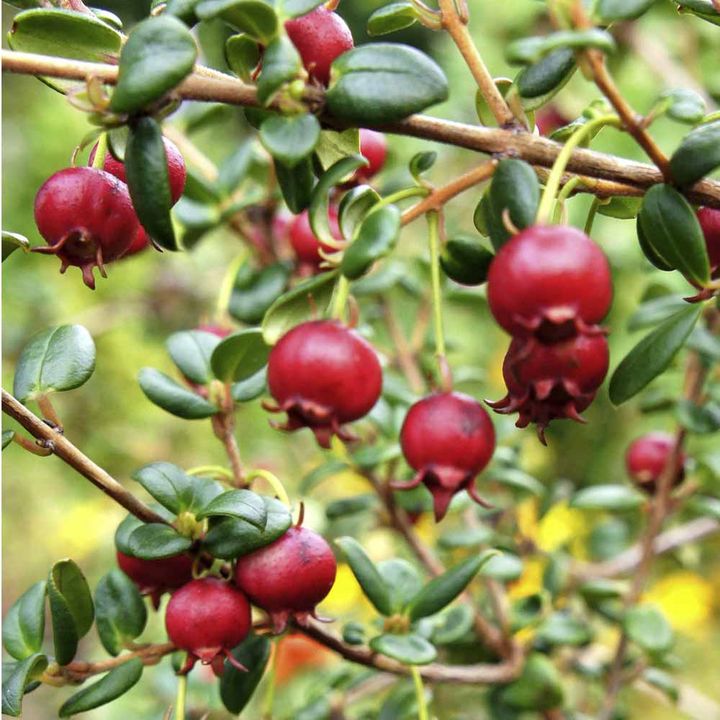

Frequently asked questions about the fruit
What does a guava look like?
The fruit of psidium is shaped like apples. They range from green to yellowish, sometimes cream in color. Depending on the variety, the flesh of the berries is white, yellow or pink.
What does guava taste like?
These fruits have a unique taste. They resemble at the same time strawberries, pears, figs and quince. In order to fully enjoy the unique taste, it is better to buy guavas, packaged at home. For example, in cans of syrup.
How is guava eaten?
Since it is an exotic fruit in Russia, many do not know how to eat guava correctly. It is mostly eaten raw, cut in two like a kiwi. Ripe pulp is very juicy and soft, so it is convenient to pick it up with a spoon. The seeds can be swallowed, but it is not recommended to chew them.
Growing
The psidium needs good lighting. However, the crown will have to be protected from direct rays. An ordinary tulle curtain, mosquito net or light translucent fabric is suitable for this. The best solution is to position the Guava on a window facing west or east.
In winter, as a rule, the tree suffers from a lack of sunlight. Many growers save the day by using fluorescent lamps. They are installed at a distance of a meter from the crown of Psidium and left on for 8-10 hours.
Summer is the time to let the plant breathe fresh air. The bush can be taken out into the garden.The place should be protected from the scorching sun and drafts.
From March to August, Guava prefers temperatures in the range of + 22-25 ° С. It is recommended to keep the shrub cool in autumn and winter. However, the thermometer should not fall below + 15 ° C.
For irrigation, use soft water at room temperature, which has stood for at least a day. The topsoil must dry out before wetting the soil again. In the warm season, Psidium drinks a lot, but with the onset of cold weather, watering is limited.
First steps after purchase
When choosing a plant in a store, close attention is paid to the stems and leaves. They should be free of mold, mucus, small insects. If a specimen is purchased that bears fruit, look at the fruits. They should be dense to the touch, with a whole peel without cuts or other traces of mechanical damage.
When Guava is at home, you should not rush to transfer. The beginner should be allowed to get used to the new conditions. A short quarantine will not hurt. After that, the plant is placed in a permanent place. Replacing the pot and soil is best done in the spring.
Commercial planting
Agricultural crops that provide a market where there is a demand for this fruit are available in many countries. They are in India, Colombia, Brazil, Cuba, Thailand, Vietnam, China, where they fully cover the need for this crop in their countries and send fruits for export.
In addition, guava grows naturally in small groves. They are considered weed plants, as they interfere with agricultural work, such plantings are subject to felling. The population is engaged in the collection of wild fruits. They can be found in Cuba, Fiji, Hawaii, Florida.
Where and at what price to buy
It is difficult to find such exotic in an ordinary supermarket, so you can buy guava in online stores of exotic fruits and vegetables.
| Name | price, rub. |
| Fresh guava (Thailand), 250 g | 300 |
| Dried (Thailand), 150 g | 210 |
| In Thai Food King syrup (Thailand), 565 g | 260 |
| Natural guava puree Ponthier (South Africa), 1kg | 1200 |
You can order the fruit fresh and thermally processed with delivery to all regions of Russia.
Psidium guinense (Brazilian guayava)
The Brazilian guayava (Psidium guineense) is very similar to the psidium guayava. Outwardly, it differs, first of all, in young shoots: in the classic guava, they are tetrahedral in cross-section, and in the Brazilian one, they are rounded. The size of the plant also differs - the Brazilian guayava is much smaller. Distributed in Brazil, Argentina and southern Mexico.
- Leaves about 18 cm long, opposite (like all myrtle leaves), oval, slightly pubescent, light green.
- Grows more like a bush than a tree. The bark is gray-brown, cracks and flakes in places.
- Flowers are collected in inflorescences like a complex panicle.
- Psidium guinense blooms in our conditions, mainly in spring and sometimes in autumn.
- Fruits that set in the fall must be removed, because in the conditions of an apartment in winter, they will not be able to ripen.


Photo: peeling off the bark on the trunk
Growing
Brazilian guayava is easily grown from seed. When propagated by seeds, the first flowering occurs in the 3rd year. It blooms profusely at once, in the first flowering it can give 100 or more flowers. It tolerates pruning well, but at the same time "shows character" and grows all the same "in its own way", not giving in well to formation.
Ripe fruits have a yellow skin and a juicy light creamy flesh. Fruits ripened in bright light have a pleasant, memorable taste and aroma. Basically, the plant is self-pollinated, but it is better to additionally pollinate with a brush during flowering.
Withstands a short-term drop in temperature to 0 ° C, while the plant becomes hardened, the leaves turn red. Suitable not only for home keeping, but also from spring to autumn frosts can be kept outdoors.
Prefers sunny exposure. The composition of the soil does not play a significant role, the exceptions are strongly acidic and alkaline soils.
It winters well on an insulated loggia or in a winter garden at a temperature of 7-12˚С. It leaves the wintering state later than other myrtle.


Photo: home-ripened fruits of the Brazilian guava
Origin story
The homeland of this plant is called the territory of Central and South America. This culture was first discovered by the Spaniards in Peru. The history of this plant does not differ much from the history of other southern fruits. Guava grew in the lands of South America, and the Indians ate it, enjoyed the taste and useful properties, they built houses from it, made ink from the leaves, until the moment when the Spaniards invaded them - the conquistadors. Having found guava orchards, the Spaniards thought they were in paradise and decided to share this paradise fruit with the whole world. So the tropical fruit began to grow in almost all countries with a southern position. It can also be found in the tropics and subtropics of Asia, Africa and America.
Perhaps everyone will be interested to know about the medicinal properties and dangers of pears.
Why is guava often consumed immature?
One of the beneficial qualities of guayaba as an exotic fruit is its low sugar content, and the peel of unripe fruit has the unique property of lowering blood glucose levels, which prompts people to eat not quite ripe fruits. They also contain many useful substances:
- calcium oxalate, sodium;
- potassium oxalate;
- carotene;
- protein;
- many other components that a person needs for full development.
But it should be clarified that the use of unripe fruits can negatively affect the body.
back to menu ↑
What are the benefits of a tropical apple?
Due to its rich complex of nutrients, psidium is recommended to be used for the prevention and treatment of many diseases, namely:
- with gastrointestinal problems;
- for the treatment of inflammatory processes in the throat;
- with lung diseases;
- to relieve seizures and epileptic seizures;
- with heart disease.
The beneficial properties of guava fruit also relate to its peel: it contains antioxidants in an amount that exceeds their composition in the pulp of the fruit itself. Eating guava whole, together with the skin, helps relieve pain and spasms, helps relieve inflammation and acts as an antineoplastic agent in combination with the main therapy.
In addition to juicy healthy pulp, leaves are also used for medicinal purposes. In folk medicine, decoctions from guava leaves are recommended to be taken for coughs, diseases of the oral cavity, dysentery. Herbal tea made from fresh leaves will help with frequent dizziness and will serve as an excellent tonic.
Guava crown formation at home:
The formation of Guava-Psidium begins when it reaches a height of 30 cm. The top of the plant is cut off after which branching begins. After this procedure, 3-4 branches with the best arrangement are allowed to grow up to 60-90 cm, after which their tops are pinched. The rest of the branches that are not located in the best way need to be removed. Further pinching is carried out as the branches grow.
Every year, the guava needs to be sanitized, all unnecessary branches are removed, which strongly thicken the crown, dry and damaged, and maintain the desired height and shape. Branches that bore fruit last season are also cut off. This pruning stimulates additional branching of the guava, usually new branches emerge from lateral buds or at the ends of the shoots.
The old guava can be rejuvenated by cutting off all the old thick branches. After such a radical pruning, the tree quickly grows young stems.
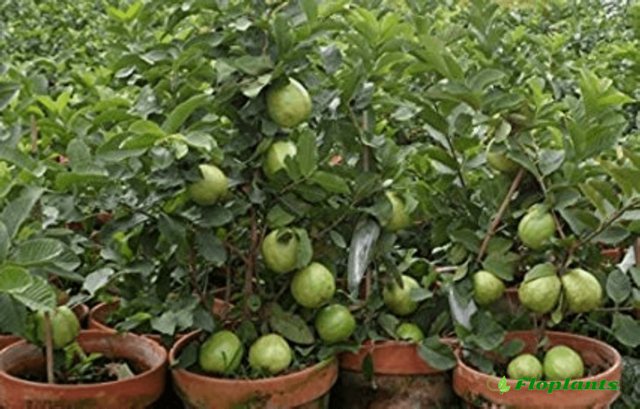

Photo
The photo shows the Guayava plant:
How to store properly at home
The tropical fruit has a pronounced aroma, so it is recommended to pack the fruit in a plastic container or plastic bag when storing.The shelf life of ripe fruit is 7-10 days at a temperature of 20 ° C, and at 8 ° C and a relative humidity of no more than 60% - more than three weeks.
Tropical apple fruits are sensitive to hypothermia and direct exposure to UV rays. Failure to comply with storage conditions may result in:
- fungal diseases;
- sunburn;
- discolored spots.
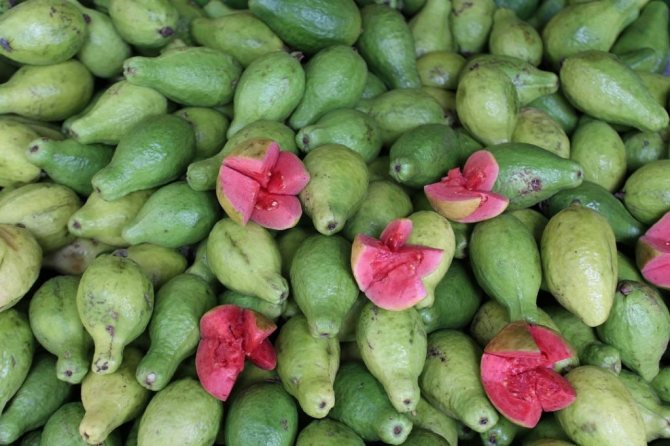

Transfer
Psidium is transplanted as the rhizome grows. Pots should be sized in proportion to the rhizome. Young plants are replanted every 1-2 years, while older plants are replanted every 3-5 years. The soil is partially scraped off the roots to prevent excessive soil acidification. A layer of drainage materials is laid out at the bottom of a deep pot. The soil for planting psidium should include the following components:
- river sand;
- garden land;
- leafy land;
- peat;
- deciduous humus.
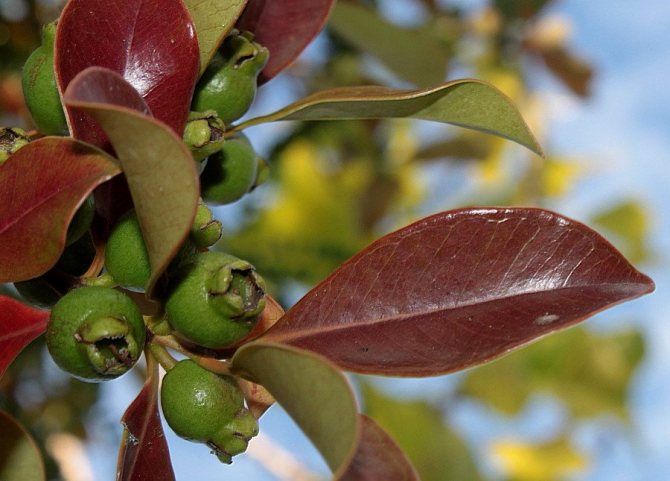

After transplanting, the plant is placed in a shaded place for 1-2 weeks.

